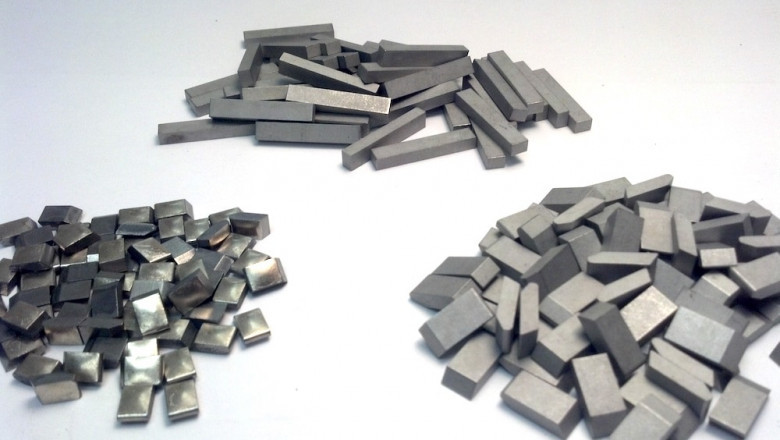views
Composition and Structure of Tungsten Carbide
Tungsten carbide is a chemical compound consisting of mostly tungsten and carbon atoms bonded together. It has the chemical formula WC and is formed when tungsten is combined with carbon at high temperatures. Tungsten carbide is a hard brittle ceramic that is heat and corrosion resistant. The hexagonal crystalline structure of tungsten carbide contributes to its high hardness. In this structure, the carbon and tungsten atoms are arranged in a repeating six-sided tight-knit pattern throughout the material. The strong metallic and covalent bonds between the carbon and tungsten atoms give tungsten carbide its hardness and toughness.
Applications in Cutting Tools and Abrasives
Due to its extreme hardness that rivals diamond, Tungsten Carbide finds extensive application in cutting tools and abrasives. It is often used as the cutting tip material in drill bits, saw blades, lathe tools and milling cutters used in machining operations. Being heat and wear resistant, tungsten carbide tools are able to withstand the friction and heat generated during cutting. This allows them to machine tough materials like steel, cast iron, and hard non-ferrous materials. Tungsten carbide is also used as an abrasive in grinding wheels, sandpaper, honing stones and lapping compounds. Its high hardness and wear resistance makes it suitable for precision grinding and finishing applications where resistance to abrasion is important.
Usage in Dies, Molds, and Extrusion Dies
Another important application area for tungsten carbide is dies, molds and extrusion dies used in various forming processes. Due to its combination of high hardness, wear resistance and fracture toughness, tungsten carbide is often used to line dies and molds used for blanking, stamping, forming and extrusion of sheet metal and other materials. The tungsten carbide inserts and coatings provide durable, long wearing working surfaces that can withstand the frictional heat and forces involved in pressing and forming operations. This allows producers to manufacture thousands of parts from a single die or mold before repair or replacement is needed. Extrusion dies for nonferrous metals also use tungsten carbide or cermets to handle the physical demands of hot metal extrusion.
Wear Resistance Solutions in Earthmoving and Mining
The mining and earthmoving industries rely extensively on tungsten carbide components to combat wear and damage caused by frequent abrasive conditions. Bucket teeth, rock drill bits, tunnel boring machine cutters, and bulldozer and excavator wear plates all commonly use cemented tungsten carbide to maximize equipment usage times and minimize replacement costs. As one of the most wear resistant materials available, tungsten carbide parts are able to resist cracking, chipping and abrasion caused by blasting, drilling, scraping and general use in harsh environments involving loose gravel, heavy rock formations, and general earth and mineral debris. This lets earthmoving vehicles and mining machinery stay in operation longer between maintenance cycles.
Protection of Valves, Seals and Others Components
Tungsten carbide finds use as a seal and valve component material where wear and corrosion resistance are important. Its hardness makes it suitable for applications involving sliding or rotating contact with fluids. Common examples include pump shafts, valve seats and seals used in chemical and oil refining equipment. Tungsten carbide is also utilized in gate valves, ball valves and other severe service valves that handle abrasive slurries and corrosive media found in mining, oil and gas extraction and other industrial processes. Besides resistance to wear from particles, tungsten carbide valves are able to function in chemical environments where metals would corrode or degrade.
Orthopedic Implants and Prosthetics
In the medical field, tungsten carbide has proven to be a useful biocompatible material for use in orthopedic implants and joint prosthetics. It has satisfactory biocompatibility properties and is able to replicate bone hardness. Due to its mechanical properties like flexural strength and fatigue resistance, tungsten carbide is incorporated as a bearing surface material in hip and knee joint prostheses. This provides a hard, durable and corrosion resistant surface that mimics natural joint motion better than other metallic and ceramic materials. Tungsten carbide is also used in bone fracture fixtures like bone plates and bone screws where strength, inertness to tissue reactions, and x-ray visibility are important design considerations.
High Density Applications like Counterweights
Thanks to its high density which is approximately 50% greater than steel, tungsten carbide finds specialized applications where a dense, heavy mass is needed. Common examples include counterweights used in aircraft flight control surfaces like elevators and ailerons. Industrial counterweights made of tungsten carbide provide the needed neutralizing mass without excess bulk or size. The high density also makes it suitable as a neutron shielding material where low atomic number, high density plates are arranged to absorb radiation without interference. Other uses involving the density characteristic include yacht keel weights, scuba weights and scientific laboratory counterweights.
Owing to qualities like outstanding hardness, wear resistance, strength and density; tungsten carbide has become an indispensable material across many industries. Its ability to withstand friction, pressure and corrosion while maintaining precision and dimensional stability has led to extensive use in metallurgy, mining, earthmoving, hydraulics, aerospace and medical sectors. While possessing many metallic properties, tungsten carbide retains its ceramic character which gives it unique advantages over soft metals for severe service applications. Continuing developments aim to widen tungsten carbide's utility through new alloying techniques and microstructural refinements. Therefore, tungsten carbide is set to remain an essential engineering material far into the future.
Get this Report in Japanese Language:
Get this Report in Korean Language:
About Author:
Money Singh is a seasoned content writer with over four years of experience in the market research sector. Her expertise spans various industries, including food and beverages, biotechnology, chemical and materials, defense and aerospace, consumer goods, etc. (https://www.linkedin.com/in/money-singh-590844163)






















Comments
0 comment